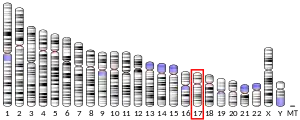Septin-4 is a protein that in humans is encoded by the SEPT4 gene.[5][6]
Function
This gene is a member of the septin gene family of nucleotide binding proteins, originally described in yeast as cell division cycle regulatory proteins. Septins are highly conserved in yeast, Drosophila, and mouse and appear to regulate cytoskeletal organization. The protein encoded by this gene is thought to be part of a complex involved in cytokinesis. Alternatively spliced variants which encode different protein isoforms have been described; however, not all variants have been fully characterized.[6]
References
- 1 2 3 GRCh38: Ensembl release 89: ENSG00000108387 - Ensembl, May 2017
- 1 2 3 GRCm38: Ensembl release 89: ENSMUSG00000020486 - Ensembl, May 2017
- ↑ "Human PubMed Reference:". National Center for Biotechnology Information, U.S. National Library of Medicine.
- ↑ "Mouse PubMed Reference:". National Center for Biotechnology Information, U.S. National Library of Medicine.
- ↑ Paavola P, Horelli-Kuitunen N, Palotie A, Peltonen L (January 1999). "Characterization of a novel gene, PNUTL2, on human chromosome 17q22-q23 and its exclusion as the Meckel syndrome gene". Genomics. 55 (1): 122–5. doi:10.1006/geno.1998.5612. PMID 9889007.
- 1 2 "Entrez Gene: SEPT4 septin 4".
Further reading
- Xie H, Surka M, Howard J, Trimble WS (1999). "Characterization of the mammalian septin H5: distinct patterns of cytoskeletal and membrane association from other septin proteins". Cell Motility and the Cytoskeleton. 43 (1): 52–62. doi:10.1002/(SICI)1097-0169(1999)43:1<52::AID-CM6>3.0.CO;2-5. PMID 10340703.
- Larisch S, Yi Y, Lotan R, Kerner H, Eimerl S, Tony Parks W, Gottfried Y, Birkey Reffey S, de Caestecker MP, Danielpour D, Book-Melamed N, Timberg R, Duckett CS, Lechleider RJ, Steller H, Orly J, Kim SJ, Roberts AB (December 2000). "A novel mitochondrial septin-like protein, ARTS, mediates apoptosis dependent on its P-loop motif". Nature Cell Biology. 2 (12): 915–21. doi:10.1038/35046566. PMID 11146656. S2CID 12321788.
- Zieger B, Tran H, Hainmann I, Wunderle D, Zgaga-Griesz A, Blaser S, Ware J (December 2000). "Characterization and expression analysis of two human septin genes, PNUTL1 and PNUTL2". Gene. 261 (2): 197–203. doi:10.1016/S0378-1119(00)00527-8. PMID 11167005.
- Tanaka M, Tanaka T, Kijima H, Itoh J, Matsuda T, Hori S, Yamamoto M (August 2001). "Characterization of tissue- and cell-type-specific expression of a novel human septin family gene, Bradeion". Biochemical and Biophysical Research Communications. 286 (3): 547–53. doi:10.1006/bbrc.2001.5413. PMID 11511094.
- Tanaka M, Kijima H, Itoh J, Matsuda T, Tanaka T (June 2002). "Impaired expression of a human septin family gene Bradeion inhibits the growth and tumorigenesis of colorectal cancer in vitro and in vivo". Cancer Gene Therapy. 9 (6): 483–8. doi:10.1038/sj.cgt.7700460. PMID 12032658.
- Vega IE, Hsu SC (January 2003). "The septin protein Nedd5 associates with both the exocyst complex and microtubules and disruption of its GTPase activity promotes aberrant neurite sprouting in PC12 cells". NeuroReport. 14 (1): 31–7. doi:10.1097/00001756-200301200-00006. PMID 12544826. S2CID 22757290.
- Ihara M, Tomimoto H, Kitayama H, Morioka Y, Akiguchi I, Shibasaki H, Noda M, Kinoshita M (June 2003). "Association of the cytoskeletal GTP-binding protein Sept4/H5 with cytoplasmic inclusions found in Parkinson's disease and other synucleinopathies". The Journal of Biological Chemistry. 278 (26): 24095–102. doi:10.1074/jbc.M301352200. PMID 12695511.
- Choi P, Snyder H, Petrucelli L, Theisler C, Chong M, Zhang Y, Lim K, Chung KK, Kehoe K, D'Adamio L, Lee JM, Cochran E, Bowser R, Dawson TM, Wolozin B (October 2003). "SEPT5_v2 is a parkin-binding protein". Brain Research. Molecular Brain Research. 117 (2): 179–89. doi:10.1016/S0169-328X(03)00318-8. PMID 14559152.
- Gottfried Y, Rotem A, Lotan R, Steller H, Larisch S (April 2004). "The mitochondrial ARTS protein promotes apoptosis through targeting XIAP". The EMBO Journal. 23 (7): 1627–35. doi:10.1038/sj.emboj.7600155. PMC 391065. PMID 15029247.
- Bläser S, Horn J, Würmell P, Bauer H, Strümpell S, Nurden P, Pagenstecher A, Busse A, Wunderle D, Hainmann I, Zieger B (May 2004). "The novel human platelet septin SEPT8 is an interaction partner of SEPT4". Thrombosis and Haemostasis. 91 (5): 959–66. doi:10.1160/TH03-09-0578. PMID 15116257. S2CID 22853459.
- Elhasid R, Sahar D, Merling A, Zivony Y, Rotem A, Ben-Arush M, Izraeli S, Bercovich D, Larisch S (July 2004). "Mitochondrial pro-apoptotic ARTS protein is lost in the majority of acute lymphoblastic leukemia patients". Oncogene. 23 (32): 5468–75. doi:10.1038/sj.onc.1207725. PMID 15122323.
- Martínez C, Sanjuan MA, Dent JA, Karlsson L, Ware J (September 2004). "Human septin-septin interactions as a prerequisite for targeting septin complexes in the cytosol". The Biochemical Journal. 382 (Pt 3): 783–91. doi:10.1042/BJ20040372. PMC 1133953. PMID 15214843.
- Lotan R, Rotem A, Gonen H, Finberg JP, Kemeny S, Steller H, Ciechanover A, Larisch S (July 2005). "Regulation of the proapoptotic ARTS protein by ubiquitin-mediated degradation". The Journal of Biological Chemistry. 280 (27): 25802–10. doi:10.1074/jbc.M501955200. PMID 15837787.
- Lee JW, Soung YH, Young Kim S, Woo Nam S, Sang Park W, Young Lee J, Jin Yoo N, Lee SH (2006). "Mutational analysis of proapoptotic ARTS P-loop domain in common human cancers". Pathology, Research and Practice. 202 (2): 67–70. doi:10.1016/j.prp.2005.11.001. PMID 16376484.
- Lee JW, Soung YH, Kim SY, Nam SW, Park WS, Lee JY, Yoo NJ, Lee SH (2006). "Mutational analysis of P-loop domains of proapoptotic Nod1 and ARTS genes in colon carcinomas". Acta Oncologica. 45 (1): 101–2. doi:10.1080/02841860500374497. PMID 16464805. S2CID 218896700.
- Garcia W, de Araújo AP, Neto Mde O, Ballestero MR, Polikarpov I, Tanaka M, Tanaka T, Garratt RC (November 2006). "Dissection of a human septin: definition and characterization of distinct domains within human SEPT4". Biochemistry. 45 (46): 13918–31. doi:10.1021/bi061549z. PMID 17105210.
This article is issued from Wikipedia. The text is licensed under Creative Commons - Attribution - Sharealike. Additional terms may apply for the media files.




